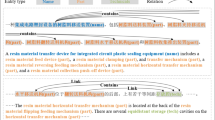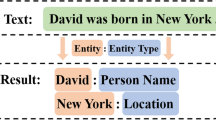Abstract
Named entity relations are a foundation of semantic networks, ontology and the semantic Web, and are widely used in information retrieval and machine translation, as well as automatic question and answering systems. In named entity relations, relational feature selection and extraction are two key issues. The location features possess excellent computability and operability, while the semantic features have strong intelligibility and reality. Currently, relation extraction of Chinese named entities mainly adopts the Vector Space Model (VSM), a traditional semantic computing or the classification method, and these three methods use either the location features or the semantic features alone, resulting in unsatisfactory extraction. A relation extraction method of Chinese named entities called LaSE is proposed to combine the information gain of the positions of words and semantic computing based on HowNet. LaSE is scalable, semi-supervised and domain independent. Extensive experiments show that LaSE is superior, with an F-score of 0.879, which is at least 0.113 better than existing extraction methods that use either the location features or the semantic features alone.













Similar content being viewed by others
References
Chinchor NA (1998) Overview of MUC-7/MET-2. In: Proc of the 7th message understanding conference
Haspelmath M (2001) Word classes and parts of speech. In: Proc of the international encyclopedia of the social and behavioral sciences, Amsterdam, Holland, pp 16538–16545
Zhang HP, Yu HK, Xiong DY, Liu Q (2003) HHMM-based Chinese lexical analyzer ICTCLAS. In: Proc of the 2nd SIGHAN workshop at ACL-41, Sapporo, Japan, pp 184–187
Wang L, Che W, Liu T (2009) An SVMTool-based Chinese POS tagger. J Chin Inf Process 23:16–21
He TT, Xu C, Li J (2006) Named entity relation extraction method based on seed self-expansion. Comput Eng 32:183–184
Deng B, Fan XZ, Yang LG (2007) Entity relation extraction method using semantic pattern. Comput Eng 33:212–214
Liu L, Li BC, Zhang XF (2008) Named entity relation extraction based on SVM training by positive and negative cases. J Comput Appl 6:1444–1446
Zhou G, Su J, Zhang J, Zhang M (2005) Exploring various knowledge in relation extraction. In: Proc of 43th annual meeting of the association for computational linguistics, USA
Chen JX, Ji DH, Tan CL, Niu XY (2006) Relation extraction using label propagation based semi-supervised learning. In: Proc of the 44th annual meeting of the ACL, pp 129–136
Zhao Y, Qin B, Liu T (2010) Appraisal expression recognition with syntactic path for sentence sentiment classification. Int J Comput Process Orient Lang
Che W, Liu T, Li Y (2010) Improving semantic role labeling with word sense. In: Proc of the 2010 annual conference of the North American chapter of the association for computational linguistics (NAACL-2010), Los Angeles, USA, pp 246–249
Che W, Liu T (2010) Using word sense disambiguation for semantic role labeling. In: Proc of the 4th international universal communication symposium (IUCS-2010), pp 166–173
Qin B, Zhao Y, Ding X (2010) Event type recognition based on trigger expansion. Tsinghai Sci Technol 15:251–258
Xu J, Zhang ZX, Wu ZX (2008) Review on techniques of entity relation extraction. New technology of library and information service, pp 18–23
Brin S (1998) Extracting patterns and relations from the WWW. In: Proc of the WebDB workshop at 6th international conference on extending database technology, Valencia, Spain, pp 172–183
Agichtein E, Gravano L (2000) Snowball: extracting relations from large plain-text collections. In: Proc of the 5th ACM international conference on digital libraries, Texas, USA
Etzioni O, Cafarella M, Downey D (2005) Unsupervised named-entity extraction from the Web: an experimental study. Artif Intell 165:91–134
Aone C, Santacruz MR (2000) REES: a large-scale relation and event extraction system. In: Proc of the 6th applied natural language processing conference, New York, USA, pp 76–83
Banko M, Cafarella MJ, Soderland S (2007) Open information extraction from the Web. In: Proc of the IJCAI-2007, Hyderabad, India, pp 2670–2676
Downey D, Etzioni O, Soderland S (2005) A probabilistic model of redundancy in information extraction. In: Proc of the IJCAI-2005, Scotland, UK
Iria J (2005) T-Rex: a flexible relation extraction framework. In: Proc of the 8th annual colloquium for the UK special interest group for computational linguistics (CLUK-2005), Manchester, UK
Iria J, Ciravegna F (2005) Relation extraction for mining the semantic web. In: Proc of the machine learning for the semantic web Dagstuhl seminar. Dagstuhl, Germany
Specia L, Motta E (2006) A hybrid approach for extracting semantic relations from texts. In: Proc of the 2nd workshop on ontology learning and population at COLING/ACL-2006, Sydney, Australia, pp 57–64
Banko M, Etzioni O (2008) The tradeoffs between open and traditional relation extraction. In: Proc of the ACL-2008, pp 28–36
Ngai G, Florian R (2001) Transformation-based learning in the first lane. In: Proc of the NAACL-2001, pp 40–47
Wang JS, Byrnes J, Valtorta M, Huhns M (2012) On the combination of logical and probabilistic models for information analysis. Int J Appl Intell 36:472–497
Daybelge T, Cicekli I (2011) A ranking method for example based machine translation results by learning from user feedback. Int J Appl Intell 35:296–321
Wong TL (2011) Learning to adapt cross language information extraction wrapper. Int J Appl Intell
Dong J, Sun L, Feng YY (2007) Chinese automatic entity relation extraction. J Chin Inf Process 21:80–85
Li H, Pan Z, Duan L, Chen J (2010) A new feature weight strategy in Chinese question classification. J Comput Inf Syst 6:113–119
Liu Z, Zhu C, Zhao T (2010) Chinese named entity recognition with a sequence labeling approach: based on characters or based on words. In: Advanced intelligent computing theories and applications. With aspects of artificial intelligence, vol 6216, pp 634–640
Gao XX, Kuang T (2011) Research of word similarity model based on HowNet. In: Proc of the EMEIT-2011, pp 287–290
Liu QL, Gu XF, Li JP (2010) Researches of Chinese sentence similarity based on HowNet. In: Proc of the ICACIA-2010, pp 26–29
Jing LP, Ng MK, Huang JZ (2010) Knowledge-based vector space model for text clustering. Knowl Inf Syst 25:35–55
Tamine LL, Boughanem M, Daoud M (2010) Evaluation of contextual information retrieval effectiveness: overview of issues and research. Knowl Inf Syst 24:1–34
Li SJ, Zhang J, Huang X (2002) Semantic computation in a Chinese question answering system. J Comput Sci Technol 17:933–939
Lu S, Bai S, Huang X (2002) An unsupervised approach to word sense disambiguation based on sense-words in vector space model. J Softw 13:1082–1089
Dorji TC, Atlam ES, Yata S, Fuketa M, Morita K, Aoe JI (2011) Extraction, selection and ranking of field association (FA) terms from domain-specific corpora for building a comprehensive FA terms dictionary. Knowl Inf Syst 27:141–161
Yang SH, Hu BG (2011) Discriminative feature selection by nonparametric Bayes error minimization. Knowl Inf Syst
Zhang X, Chen GQ, Wei Q (2011) Building a highly-compact and accurate associative classifier. Int J Appl Intell 34:74–86
Zhang R, Tran T (2011) An information gain-based approach for recommending useful product reviews. Knowl Inf Syst 26:419–434
Wang B (1999) Auto-alignment study of Chinese-English bilingual corpora. PhD thesis, Institute of Computing Technology, Chinese Academy of Sciences
Pham MQN, Nguyen ML, Ngo BX, Shimazu A (2012) A learning-to-rank method for information updating task. Int J Appl Intell
Li JH, Zhou GD (2011) Unified semantic role labeling for verbal and nominal predicates in Chinese language. ACM Trans Asian Lang Inf Process 10:13:1–13:21
Liu C, Li SJ (2002) Word similarity computing based on HowNet. Comput Linguist Chin Lang Process 7:59–76
Li L, Ogihara M, Ma S (2010) On combining multiple clusterings: an overview and a new perspective. Int J Appl Intell 33:207–219
Liu YH, Yang CS, Yang YB, Lin FH, Du XM, Ito T (2012) Case learning for CBR-based collision avoidance systems. Int J Appl Intell 36:308–319
Author information
Authors and Affiliations
Corresponding author
Additional information
This work is supported by the National High Technology Research and Development Program of China (863 Program) under grant 2012AA011005; the National Natural Science Foundation of China (NSFC) under grants 60828005 and 60975034; and the Natural Science Foundation of Anhui Province of China under grant 090412044. An earlier version of this paper was presented at the 2009 IEEE International Conference on Granular Computing.
Rights and permissions
About this article
Cite this article
Li, H., Wu, X., Li, Z. et al. A relation extraction method of Chinese named entities based on location and semantic features. Appl Intell 38, 1–15 (2013). https://doi.org/10.1007/s10489-012-0353-0
Published:
Issue Date:
DOI: https://doi.org/10.1007/s10489-012-0353-0




